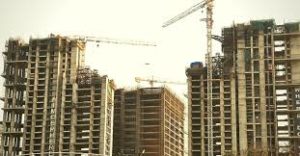Developers are likely to offer freebies such as deferred payment plans to buyers investing in the mid segment, while luxury housing may see a 20 percent reduction in prices.
Indian real estate sector is reeling under the deadly impact of the corona virus pandemic.Like with every sector, this pandemic too may give up opportunities for buyers as several cash-starved developers with unsold inventory may be forced to sell at discounted prices.
While luxury housing may see a 20 percent reduction in prices, developers would offer freebies to buyers investing in the mid segment. These may range from deferred payment plans to even a free Corona insurance that may address their fears of a job loss. Affordable housing may see a moderate price correction of 5 percent and also a fall in volume.
HDFC Chairman Deepak Parekh recently said that he sees a 20 per cent drop in property prices of unsold residential inventory, and advised developers to offload their stocks to enhance liquidity position. He also cautioned developers against over leveraging, which can affect their businesses in the long-run.
A report by HDFC Securities had noted that large NBFCs expect further 20-25 percent cuts in the real estate prices and a 25-30 percent dip in volumes for the financial year 2021 along with fiscal incentives like stamp duty waivers. This shall aid demand recovery. The market may consolidate in the hands of select large organised developers with strong balance sheet and access to bank funding. JDA (Joint Development Agreement )/JV(Joint Venture) model will continue and land buying will take a back seat. Launches will get deferred and focus will be on completing existing unsold area.
An analysis by Liases Foras has also predicted that property prices may come down by 10-20 percent across geographies, while land prices could see an even higher reduction of 30 percent.
Luxury real estate projects are bound to witness a reduction in prices across the country, anything from 10 to 20 percent depending on the location, city and the demand supply situation. These are units priced at Rs 2.5 crore and above, say real estate experts.
In the mid-segment category where units are priced between Rs 1 crore to Rs 1.5 crore, there may be a slight correction as developers may instead decide to offer freebies instead of direct discounts.
it’s important to understand here is that this segment is popular with the fence sitters(need to get off the fence and buy). The builder community may try to get into a demand boosting exercise to motivate this segment to buy.
“Reduction in prices or discounts alone may not be a motivator for this segment. The developer may decide to entice them with intelligent freebies,” said an expert.
Builders going forward may decide to address this segment’s chief fears which include a job loss three months down the line, a probably reduction in price or “what happens if I get corona”.
Experts said that real estate builders would have to think indicatively to generate cash flows.
“The biggest challenge in the market today is the revival of demand. That can be achieved either by reducing property prices, bringing down the cost of financing or mortgage rates and introducing a better tax structure for both direct and indirect taxes,” said Real State Advisers,also says”Such schemes would go a long way in addressing fears of a job loss, fear of value erosion of a property and most important the fear of contracting the disease itself,”
Builders may promise a price guarantee option to boost sales. This means that if a house is worth Rs 1 crore and if prices were to come down in a few months or the buyer were to lose his job, the developer as per this scheme, decide to buy back the house from the buyer and also offer a 6 percent interest on the amount.
This could ensure that the buyer not only gets back his money but also an amount equivalent to what he would have earned had he parked his money in a fixed deposit. A win-win proposition.Some builders may decide to offer a Corona insurance for the entire family.
The buyer pool may shrink going forward but discounts alone may not do the trick. Deferred payment plans without subvention may become popular.
“One may see developers coming up with deferred payment plans such as 10:90 plan which means that the buyer may have to pay an upfront amount of 10 percent and 90 percent at the time of possession. Such payment plans may also be offered for ready-to-move-in projects,” said Mudassir Zaidi, Executive Director- North, Knight Frank India.
This means that the buyer may have to pay 10 percent at the time of moving in and perhaps the remaining 90 percent within a year.
The sub-Rs 50 lakh segment may also see a correction of 5 percent, say experts.
The Rs 10 lakh to Rs 45 lakh segment may also witness a moderate correction with some freebies thrown in.
“This segment may also see a volume correction because of significant demand erosion as the savings of these people have been eroded during the lock down,” said an expert.
Some experts are of the view that real estate prices have remained stable for the last five years and with time correction already having taken place, developers may not have enough head room to reduce prices.
“Home buyers’ resistance to prices is much less today. The bigger issue is that of timely delivery and quality of the product being offered,” said Samantak Das, Chief Economist and Head of Research & REIS, JLL India.
Going forward, some developers may decide to offer well-designed compact units to fit the buyers’ pocket.
Developers may also offer freebies such as GST and stamp duty waivers, additional gadgets in the house such as dishwashers thrown in. There may not be enough headroom to rationalize prices as prices have remained stable for almost five years now, he added.
In 2008, the real estate market was over heated. It had short-term investors and under writers, making it a sellers’ market. The price bubble led to reduction of prices by 20 percent to 30 percent. Developers’ have had a bull’s run five year’s prior to the Lehman’s crisis and their coffers were full. They therefore had enough head room to reduce prices.
Today, it is an end-users’ market. The market has been in slow mode for the last five years due to several reasons. It is still trying to come to terms with disruptions like RERA, GST implementation and the NBFC funding crisis.
The corona virus outbreak is perhaps the fourth ‘Black Swan’ event being witnessed by the Indian real estate sector in since 2016, according to a report by ICICI Securities.
Recovery after the 2008 slowdown was faster as builders had enough buffer. In the present situation, prices have stagnated or come down significantly for the last five years. Despite prices being affordable, buyers are still cautious of investing in property. Timely delivery is their main fear.
In a crisis situation like today, a developer offering a 20 percent discount would also have its own set of challenges, says an expert.






